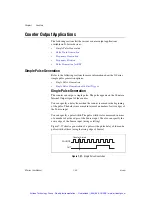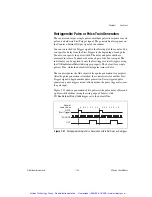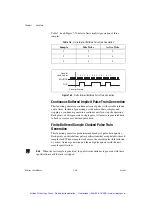
Chapter 7
Counters
©
National Instruments
7-37
X Series User Manual
Table 7-7 and Fig
u
re 7-35 detail a finite sample clocked generation of
three samples where the p
u
lse specifications from the create channel are
two ticks idle, two ticks active, and three ticks initial delay.
Figure 7-35.
Finite Buffered Sample Clocked Pulse Train Generation
There are several different methods of contin
u
o
u
s generation that control
what data is written. These methods are regeneration, FIFO regeneration
and non-regeneration modes.
Regeneration is the repetition of the data that is already in the b
u
ffer.
Standard regeneration is when data from the PC b
u
ffer is contin
u
ally
downloaded to the FIFO to be written o
u
t. New data can be written to
the PC b
u
ffer at any time witho
u
t disr
u
pting the o
u
tp
u
t. With FIFO
regeneration, the entire b
u
ffer is downloaded to the FIFO and regenerated
from there. Once the data is downloaded, new data cannot be written to the
FIFO. To
u
se FIFO regeneration, the entire b
u
ffer m
u
st fit within the FIFO
size. The advantage of
u
sing FIFO regeneration is that it does not req
u
ire
comm
u
nication with the main host memory once the operation is started,
thereby preventing any problems that may occ
u
r d
u
e to excessive b
u
s
traffic.
Table 7-7.
Finite Buffered Sample Clocked Pulse Train Generation
Sample
Idle Ticks
Active Ticks
1
3
3
2
2
2
3
3
3
S
o
u
rce
O
u
t
Co
u
nter Armed
Sa
mple
Clock
Co
u
nter
Lo
a
d V
a
l
u
e
s
2 1 0 1
0 1 0 1
2 1 0 2 1 0
0
2 1 0 2
1 0 1 0
0 2 1 0 2 1
1
0
3
2
2
2
3
3
3
3
2
3
3
2
Artisan Technology Group - Quality Instrumentation ... Guaranteed | (888) 88-SOURCE | www.artisantg.com
















































